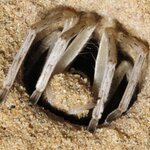Ecology & Zoology

If you ask rural people in the American east which is more damaging to the ecology, coyotes or deer, it may be a toss-up. But that doesn't mean it is a good idea for one to just take the other out.
In most states, deer population management also brings revenue benefits - hunting licenses and meat - but coyotes aren't hunted. They haven't been arrived that long. Coyotes -- Canis latrans -- have long inhabited the American West but are a relatively recent arrival to eastern North America, appearing first in the region in noticeable numbers in the 1970s. They have already become a…

A spider in the Moroccan Sahara rolls like a tumbleweed and can do powerful, acrobatic flips through the air.
Cebrennus rechenbergi runs for a short time, then stretches out its front legs, spinning into the air and returning to touch the ground with its hind legs. The move doubles the spider’s speed, to two meters per second. But since it uses so much energy, the maneuver is a last resort, called on only to escape predators.
“I can’t see any other reason,” said Peter Jäger, a taxonomist at the Senckenberg Research Institute and Natural History Museum in Frankfurt, Germany,…

Some Ecuadorian tribes were famous for making mummified shrunken heads (click for the recipe) from the remains of their conquered foes.
Perhaps they got the idea from nature. Field work in the cloud forests of Ecuador has resulted in the discovery of 24 new species of Aleiodes wasps - that mummify caterpillars. 24 new insect are species described by Eduardo Shimbori and Scott Shaw in ZooKeys and they don't mind glorifying celebrities in the naming.
One wasp causes its host caterpillar to bend and twist in an unusual way so the authors did their own twisting and decided that needed…

There are about 9,700 known species of grasshoppers in the world. Now there is one more, and it has beeen named Grammy-award winning singer and Mexican activist Ana Lila Downs Sanchez.
Locals called the creature the friar grasshopper because its head looks a bit like what a monk with his hood pulled back might look like and so the scientific name of the new grasshopper is Liladownsia fraile. In Spanish, "friale" means friar.
The new species was discovered on the side of a mountain road near Oaxaca, Mexico.
The men were doing fieldwork for another grasshopper study in…

How can science help save the wild finches Darwin made famous in the Galapagos Islands from invasive species?
By leaving cotton balls treated with a mild pesticide laying around. In an experiment, the wild finches used the cotton to help build their nests, which killed parasitic fly maggots and protected baby birds.
Self-fumigation works.
"We are trying to help birds help themselves," says biology professor Dale Clayton, senior author of a study outlining the new technique in Current Biology.
A finch in Ecuador's Galapagos Islands pulls a cotton ball from a dispenser set out by scientists…
"The spotted owl is the poster boy on how to use the Endangered Species Act to accomplish a goal beyond the species itself and how things can get messed up."
Ban Nock writing in the Daily Kos
The U.S. Department of the Interior has taken aim at the U.S. Department of Agriculture’s iconic Woodsy Owl, who used to say, “Give a hoot. Don’t pollute.” but now says, “Wait! Don’t shoot!”
In hopes of helping the northern spotted owl’s numbers increase, starting this fall, the United States Fish&Wildlife Service plans to “remove barred owls from parts of up to four study areas in the northern…

A paper in Zootaxa describes a new species of spider, Cebrennus rechenbergi, the only spider that is able to move by means of flic-flac jumps.
The nocturnal spider Cebrennus rechenbergi lives in the sand desert Erg Chebbi in southeastern Morocco, not far from the Algerian border.
With its feelers and specialized, elongated bristles, Cebrennus rechenbergi creates a tube-like domicile in the sand, attached by silk threads, which offers protection from the sun and predators. The spider’s most outstanding talent, however, is its ability to move by means of flic-flac jumps. Unlike its…

It's official - females prefer courtship over competitiveness. And she may talk with her friends about the size of your mandibles, but it really doesn't matter.
Female mate choice and male-male competition are typical mechanisms of sexual selection. However, these two mechanisms do not always favor the same males. Researchers have investigated the complicated sexual conflict over mating in Gnatocerus cornutus, the horned flour-beetle.
Male horned beetles have enlarged lower jaws – or mandibles – used to fight rivals, and those with larger mandibles do have a mating…

Sweet potato products have increased in popularity so growers and processors are interested in identifying ways to make the crop more widely available.
In the United States, sweet potatoes are grown primarily for the fresh market, where consumers prefer medium-sized, uniformly shaped products that are free of imperfections. Ramón Arancibia, lead author of a paper in HortTechnology, notes unlike fresh market products, the sweet potato processing industry can use product of all sizes.
For making sweet potato fries, for example, large roots are preferred because they are longer and a more…

Feral camels in the Australian outback are reviled as pests. Yet they thrive, totaling some one million strong.
How did they go from historic helper to overbearing invader? As usual, numbers make the difference.
The deserts of the Australian outback are a notoriously inhospitable environment where few species can survive - but camels can. The dromedary camel (Camelus dromedarius) prospers where others perish, eating 80% of native plant species and obtaining much of their water through ingesting this vegetation.
Yet for ranchers, conservation managers and, increasingly, local and…